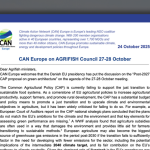In the State of the Energy Union, the Commission must address Member States’ ambition and implementation gaps towards 2030 targets
This week, the European Commission is expected to communicate on the State of the Energy Union. This exercise takes place every year, but 2025 is a significant milestone for achieving the 2030 climate and energy targets. As the European Commission takes stock of Member States’ progress towards these targets, it is expected to adopt measures to correct the course.
The opportunity to correct any ambition gap
In 2023-2024, EU Member States were required to update their National Energy and Climate Plans. These plans have a 10-year outlook and aim at presenting the policies and measures that will be adopted to achieve national climate and energy targets. In May 2025, the European Commission assessed the plans submitted to date (24 out of 27) and claimed that “their full implementation would bring the EU close to reaching its objectives”, namely achieving a 54% emissions reduction by 2030 (one percentage point short of the 55% emissions reduction target).
However, civil society organisations and think tanks have identified significant flaws in those plans. An NGO analysis published in June 2025 of 16 final revised NECPs cast serious doubts on their ability to deliver on the Member States’ respective climate and energy objectives, due to the lack of policies and measures (and related financing) to back them up. For instance, only half of the assessed NECPs include policy scenarios aligned with the required emission reductions in key sectors such as agriculture, transport, buildings, and waste. In the area of energy efficiency, most plans do not include enough policies and measures to meet the minimum contributions outlined in the Energy Efficiency Directive.
Independent stakeholders such as the European Climate Neutrality Observatory (ECNO) also highlighted important gaps. In its analysis of 22 final NECPs, ECNO highlighted that gaps are visible among others in Member States’ contributions to the EU’s renewables and energy efficiency targets, as well as projected policy impacts for emissions under the Effort Sharing Regulation, natural sinks, renewables, and energy consumption. In particular:
- In the Effort Sharing sectors, both the European Commission and ECNO identify risks of missing the EU’s 2030 ESR target by nearly 2% points.
- In the LULUCF sector, the European Commission identified a gap of about 45-60 Mt MtCO2eq compared to the 2030 target under the LULUCF Regulation. ECNO found that the EU risks missing its 2030 LULUCF target by around 13%.
- In the area of renewable energy, the Commission identified an ambition gap of 1.5% in national contributions to achieve the EU’s 2030 binding target for renewable energy share of at least 42.5% with an additional aspirational top-up of 2.5 percentage points to reach 45%.
- In the area of energy efficiency, many Member States plan insufficient national contributions to the 11.7% EU energy efficiency target according to the Commission, resulting again in an ambition gap of 8.1% for final and 7.5% for primary energy consumption.
These findings led NGOs from 8 countries to call on the European Commission to launch legal action against their governments, arguing that the shortcomings in their climate plans are not merely policy failures, but breaches of EU law. In addition to initiating infringement proceedings, the European Commission has other tools to address the aforementioned ambition gaps. Article 31(3) of the Governance Regulation requires the European Commission to act if the objectives, targets, and contributions of the NECPs or their updates are insufficient for the collective achievement of the EU’s climate and energy targets. These legal measures at the EU level should be complemented by recommendations to Member States to close the gaps (Articles 31 and 34 of the Governance Regulation). Such recommendations are mandatory only in case of gaps for renewable energy targets, but we expect the Commission to adopt country-specific recommendations in all sectors.
The Commission announced in May 2025 that it was “launching a set of operational actions to explore alternatives for closing the ambition gap”. We now expect it to take the next step and adopt both legal measures and country-specific recommendations, as well as any other operational actions that may be required, to close the abovementioned gaps.
A strong response needed to address the probable implementation gap
Alongside the ambition gap, the State of the Energy Union 2025 also provides the European Commission with an opportunity to act to close any possible gap in the progress to achieve the climate and energy targets. All 27 EU Member States are required to report every two years on how they progress towards reaching their targets via their NECPs Progress Reports. The latest progress reports were submitted to the European Commission in March 2025. Therefore, this year’s State of the Energy Union will take stock of them and assess progress towards achieving the EU 2030 climate and energy targets.
While we wait for the Commission’s assessment of the latest NECPs Progress Reports, the trend from the last few years shows some worrying signs. CAN Europe’s latest update of its NECP tracker in October 2024 showed that even the implementation of the old and less ambitious 2019 NECPs was lagging behind. All of the 17 EU Member States featured in the tracker were lagging behind in at least one of the NECP tracker indicators.
Should these trends be confirmed as part of the 2025 State of the Energy Union, we expect the European Commission to fill any implementation gaps. Article 32 of the Governance Regulation provides that, if the Commission finds that a Member State is not making sufficient progress to meet its targets, objectives, and contributions, it ‘shall’ issue recommendations to the Member States concerned. Moreover, the Commission ‘may’ further issue recommendations to all Member States if the aggregate assessment of all NECP progress reports shows that the EU is at risk of not meeting its climate and energy targets. In addition to recommendations, the Commission ‘shall as appropriate’ propose measures at the EU level to ensure the achievement of the EU 2030 targets in the area of renewable energy and energy efficiency. We therefore expect the European Commission to adopt strong recommendations and additional measures at the EU level to correct any implementation gap – including infringement procedures in case of delayed or incomplete transposition of the Renewable Energy Directive or the Energy Efficiency Directive into national law.
In parallel, the ESR and LULUCF Regulations also offer additional tools to the European Commission. If the Commission finds that a Member State is not making sufficient progress in these sectors, that Member States must submit to the Commission within three months a corrective action plan that includes, among others: 1) a detailed explanation of why it is not making sufficient progress, 2) additional actions complementing the NECP or reinforcing its implementation, 3) a strict timetable for implementing them. We therefore also expect the European Commission to require Member States to adopt such corrective action plans where necessary.



